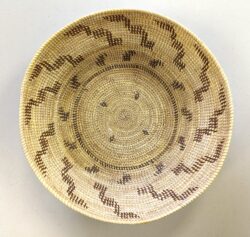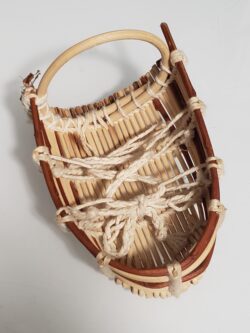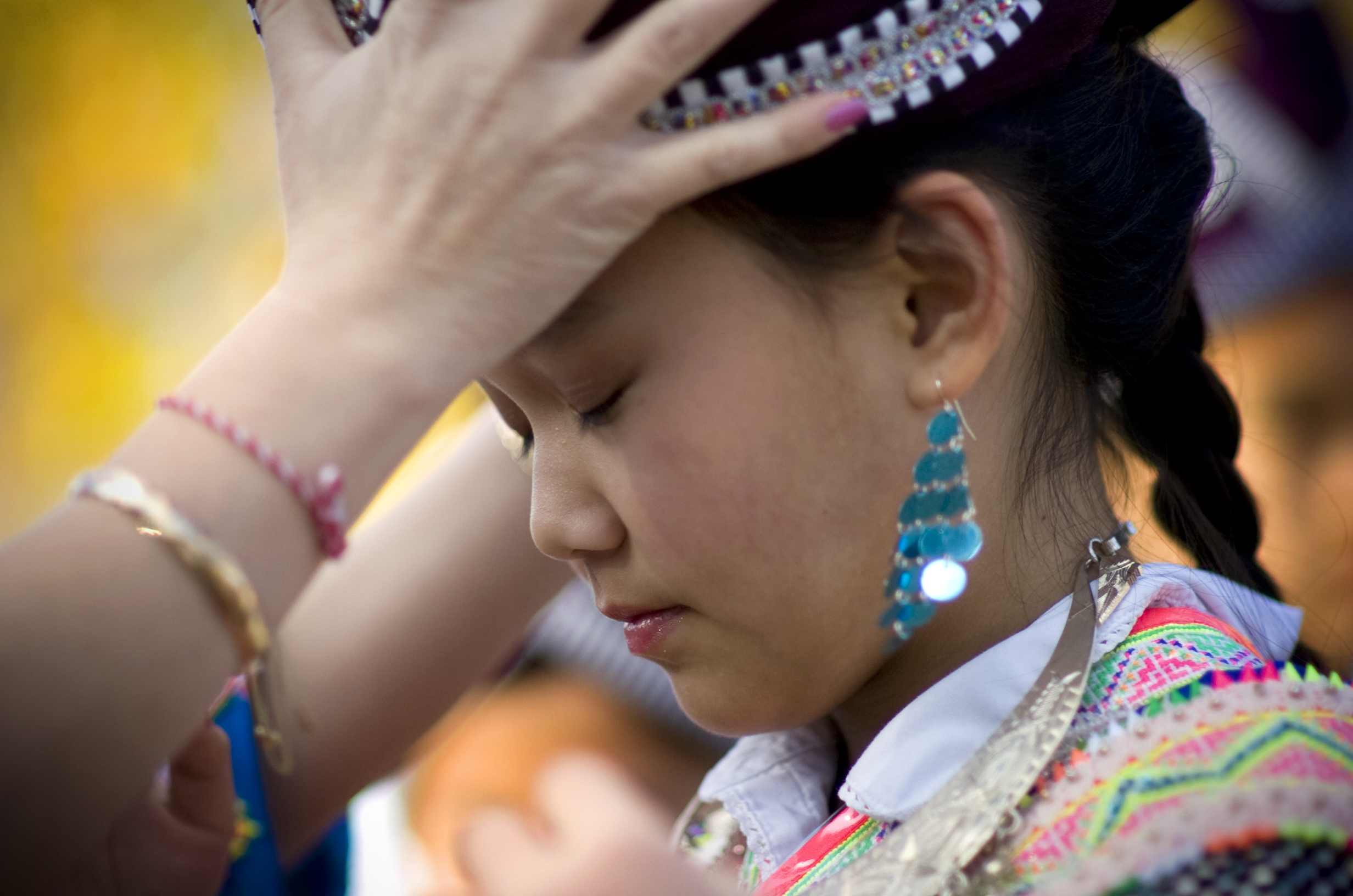Deborah McConnell + Natalie Scott (Hupa Basket Weaving)
Hoopa Valley Indian Reservation
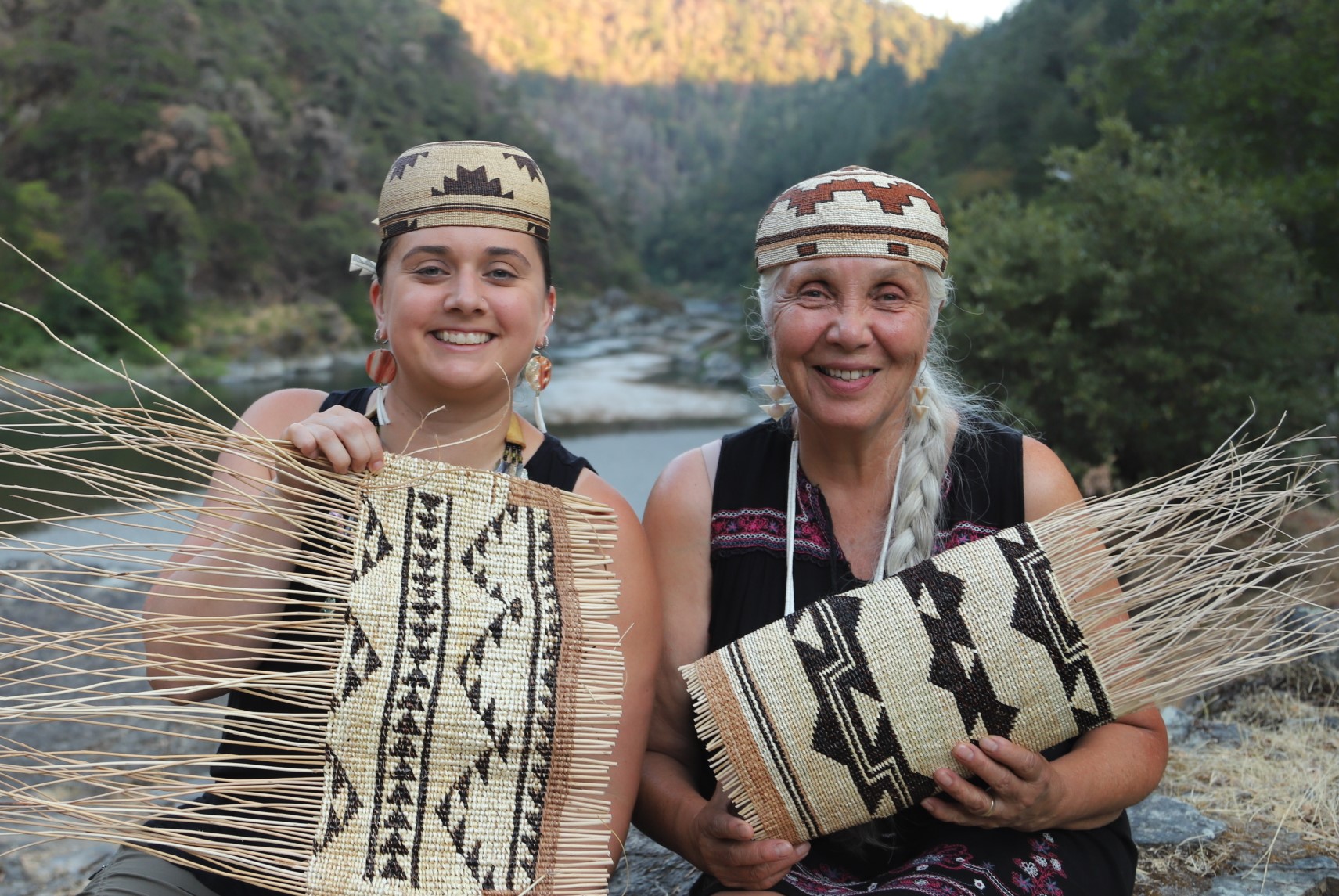
For over 48 years, master basket weaver Deborah McConnell has woven her Hupa, Yurok, and Quinault identity into her creations. Hailing from the Hoopa Valley Indian Reservation, Deborah began her weaving journey as a child, learning from esteemed artists Marilyn Hostler and Lila Colegrove. Since then, she has devoted her life to sharing Native culture through cultural arts education and mentoring, teaching in programs such as the Hoopa Tribe’s Johnson O’Malley Program, the Klamath-Trinity Joint Unified School District, the California Indian Basketweavers Association, and the Tribe’s TANF program.
“Weaving is a holistic art that includes everything: our environment, our people, and spiritual ways,” Deborah shares. “It teaches you that you are not separate from the environment—you are a part of the environment.”
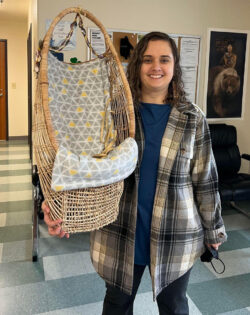
One of Deborah’s most dedicated apprentices is Natalie Scott, a cultural arts teacher at Hoopa Valley High School. Related through their great-great grandmothers, Deborah has known Natalie since she was young, and they’ve been weaving together since 2018. In 2019, their collaboration deepened when Deborah began working in Natalie’s classroom as a cultural consultant. Together, they co-teach weaving and cultural arts to local students, blending hands-on skill-building with shared cultural knowledge.
For Natalie, weaving is not just a craft: it is an act of cultural responsibility and care. Every piece she creates begins with the thoughtful gathering and preparation of materials. She has made baby baskets for family members stepping into parenthood and a Jump Dance basket for her eldest son, as well as baby rattles and wall mats—each piece marking a step in her growth as a weaver and teacher. Both she and Deborah come from ceremonial dance families in the Hupa and Yurok traditions, and carry forward distinct responsibilities and teachings from their lineages. For Natalie, the apprenticeship is also about community connection—teaching youth, preparing regalia, and engaging in broader cultural practices like salmon smoking with students at Hoopa High School.
“Out of all the people I have worked with, Natalie is for sure going to be teaching and working with the youth,” Deborah shares.

During her apprenticeship, Natalie focused on creating a ceremonial cap, a project that builds on her earlier work with rattles and overlay techniques. Gathering the materials for a cap is a yearlong process, requiring careful timing and an understanding of seasonal rhythms. Each plant must be collected at its peak—spruce roots, willow, hazel sticks, maidenhair fern—and then processed with care. Black fern is split using a rolling pin and pocket knife; woodwardia fern is pounded to release its fibers; willow roots are scraped and cleaned; hazel and willow sticks must be picked and peeled. Dyes like wolf moss and alder bark are gathered and boiled to bring color and meaning to the final piece.
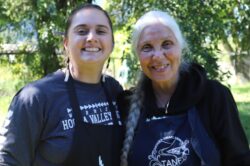
Every step in the gathering process requires intention. Some of the materials Natalie has used were gifted by her grandmother, who gathered them long ago with a specific use in mind—even though she doesn’t weave regularly herself. That care shows in how the materials handle: smooth, flexible, “buttery in your hand,” as Natalie describes it. That experience deepened her understanding of what it means to gather with purpose—to go out not just to collect, but to look for something particular, and to be in tune with what the land is ready to offer.
“People told me that you weren’t supposed to weave unless your heart was in a good place, but I learned that I had to weave to make my heart be in a good place,” shares Natalie. “It’s a holistic art.”

Weaving requires tuning into the trees, the soil, and the changing weather. Gathering materials becomes a relationship, one that cultivates presence, patience, and grounding. For Natalie, this slow, intentional practice is also deeply healing. Weaving helps her feel more confident and centered. “It’s really good mental health medicine,” she says. “If more people could sit and weave, I think we’d have more harmony in our community.”
Together, Deborah and Natalie are weaving memory, family, ecology, and ceremony into every stitch. Their work ensures that Hupa weaving remains not only visible but alive—flourishing in classrooms, homes, and ceremonial grounds across the Hoopa Valley and beyond.
Jennifer Malone + Destiny Treglown (Wukchumni Basket Weaving)
Exeter, Tulare County

Jennifer Malone, a Wukchumni elder of Wukchumni, Tachi, and Yowlumni heritage, has spent decades strengthening and advocating for the basketry traditions of her community. Based in Exeter, she is a longtime board member of the California Indian Basketweavers Association and a respected teacher who began learning from her mother, Marie Wilcox, and grandmother, Beatrice Arancis. Jennifer also apprenticed with master Chukchansi basketweaver Clara Charlie in ACTA’s Apprenticeship Program in 2001. Over the years, she has remained committed to teaching others and helping community members reclaim cultural knowledge.
“Just as the stitching holds our baskets together, basket weaving holds our community together,” Jennifer explains. “It keeps us connected to our culture and the land.”
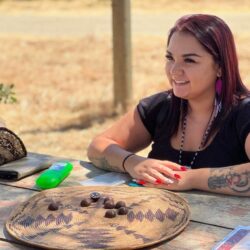
Jennifer is now mentoring her granddaughter, Destiny Treglown, in the creation of a traditional Wukchumni t’iwan, or gambling tray. This coiled basket is used to play hu’ach k’ui’angau’ihsh, the Wukchumni walnut dice game. Together, they are working not only to complete this functional and symbolic basket, but to deepen Destiny’s skills in gathering, processing, and weaving key materials like deer grass, white root, and redbud. Their lessons are grounded in cultural responsibility: tending to the land, picking up trash in gathering areas, and learning how and when to harvest plants with care and respect.
Weaving sessions take place at Jennifer’s home and on the land, including trips to gather white root, redbud, deer grass, and sour berry. Their time together is also a form of Wukchumni language immersion. As they gather and weave, Jennifer and Destiny speak to one another using traditional terms, incorporating language into their hands-on work.
“It’s not easy being a weaver, it’s a year-round commitment. Gathering, processing material, weaving, teaching, caring for the plants during the right time of year to get good material,” Jennifer says.

Destiny has been learning from Jennifer since childhood—starting with language classes at home—and now describes herself as a moderately experienced weaver still early in a lifelong path. In addition to weaving, she has participated in public education events and museum programs focused on Wukchumni culture, beadwork, language, and games. She is currently studying anthropology at College of the Sequoias, a field that she says has helped her understand the significance of ‘being living history.” Her aim is to combine Western education with Indigenous knowledge to ensure that Wukchumni culture continues for future generations.
Jennifer sees in Destiny both the dedication and potential needed to become a future master weaver. This apprenticeship is a step toward that goal, refining Destiny’s technical skills while strengthening the intergenerational threads that bind them together.
“Working with my grandma especially through basketry to me is the best form of preservation, and I hope that I can continue to share her story as well as mine through our traditions,” Destiny shares.
Melody Williams + Kayla Lowell (Pomo Basket Weaving)
Arcata, Humboldt County and Willits, Mendocino County

In 2009, Pomo basket weaver Christine Hamilton served as a mentor artist in ACTA’s Apprenticeship Program, passing on the intricate knowledge of coil and baby baskets to her niece, Melody Williams. Fifteen years later, that same program now supports Melody as she mentors her great-niece, Kayla Lowell, continuing a family legacy of learning, teaching, and cultural renewal that spans generations.

Melody, who lives in Arcata, was first introduced to basketry by her grandmother, Della Campbell, and later deepened her practice under Christine’s guidance. Her 2009 apprenticeship with Christine focused on gathering and preparing traditional materials—willow, sedge, and redbud—and mastering the techniques required to make functional baskets rooted in Pomo tradition. Today, she carries that legacy forward as both a weaver and teacher.
Baskets are more than merely ceremonial or artistic items: they are an integral part of everyday life, used to hold beads, food, or household items. In this Apprenticeship Program cycle, Melody mentored Kayla in two traditional Pomo basket styles: coiling and open twine. Together, they are creating a coiled basket and a seaweed basket, incorporating redbud patterns and family-specific designs. Like her mentor and great-aunt Melody, Kayla first began weaving baby baskets as a teenager under Christine’s guidance. Kayla brings years of hands-on experience in gathering and community-based cultural practice, and is now focused on developing the skills to become a weaver and future teacher.
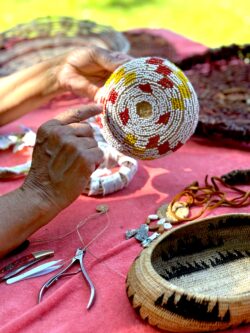
Kayla’s apprenticeship is grounded not only in weaving technique but in traditional ecological knowledge—understanding where to find basket materials, how to harvest them with care, and how seasonal cycles shape their availability. She and Melody gather sedge root, willow, and redbud on ancestral Pomo lands throughout Mendocino, Lake, and Sonoma Counties. Their monthly lessons combine hands-on weaving with deep engagement with the land, emphasizing respectful and sustainable harvesting. Each session becomes an act of cultural continuity—honoring the land, uplifting elders, and strengthening intergenerational knowledge.
For Kayla, weaving is a way to stay deeply connected to her culture and family. “We would gather together, all generations, to gather and prepare the materials and weave,” she recalls. During these gatherings, elders passed down more than technique—they shared stories, values, and teachings about respectful behavior and communication. “These times are precious to me. I want to share these types of times with the younger generations,” she shares.
“We would gather together, all generations, to gather and prepare the materials and weave. These times are precious to me,” shares Kayla.
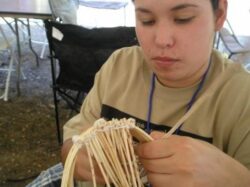
Melody sees this as a full-circle moment. She remembers when Kayla first began gathering as a teenager in 2006, learning alongside Melody’s son. Now, Melody is guiding her great-niece in mastering more advanced weaving techniques and preparing her to eventually become a teacher. “There is a peace and satisfaction in knowing that our culture is being passed on to the next generation,” Melody reflects. “My grandmother used to say that there is only one way to destroy a basket, and that is by burning it. Baskets are living—and they will live forever.”
The apprenticeship will culminate in a public exhibition at the Willits Center for the Arts’ annual Pomo art show. Melody and Kayla will also partner with a local nonprofit for a community event on their ancestral lands in Fort Bragg, featuring finished baskets, photographs, and plant materials. Just as Christine once did for Melody, Melody now guides Kayla in a tradition that is as enduring as it is alive—woven stitch by stitch through the Apprenticeship Program and across generations.
“My grandmother used to say that there is only one way to destroy a basket, and that is by burning it. Baskets are living—and they will live forever,” shares Melody.
These apprenticeship pairs remind us that Native Californian basket weaving is far more than a craft. It is a cultural lifeline, connecting people to their ancestors, their land, and their communities. As mentor Jennifer Malone notes, “Our baskets have lives. You need to use them, not just have them sit on a shelf.” Whether weaving ceremonial caps, gambling trays, or seaweed baskets, these artists and their apprentices are ensuring their sacred traditions continue to flourish in tandem with the land.
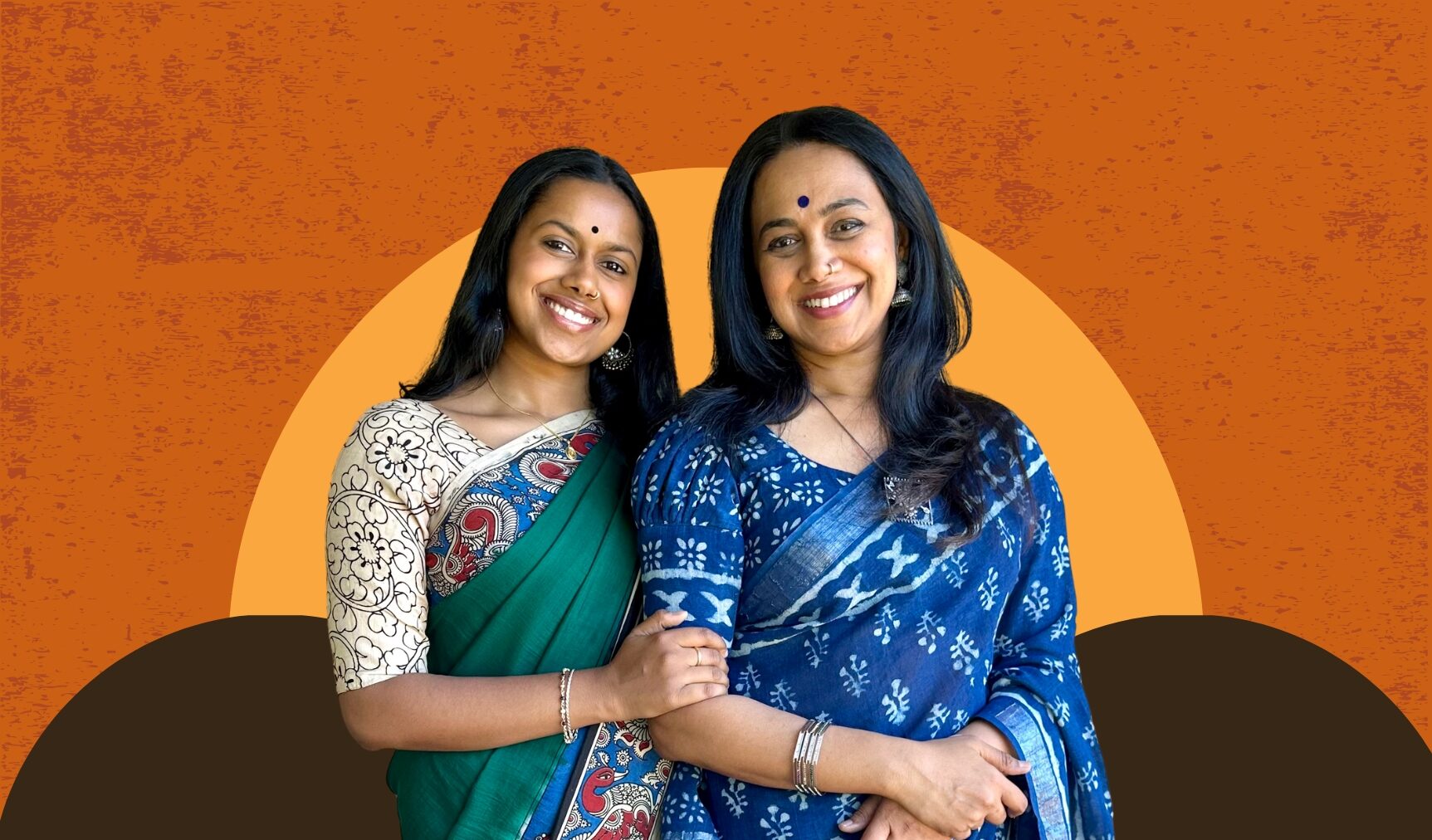
In 2024, ACTA invested $110,000 to support 22 mentor-apprentice pairs in preserving and advancing California’s diverse cultural traditions.

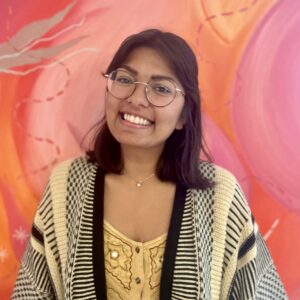 Juhi Gupta, Digital Media Specialist
Juhi Gupta, Digital Media Specialist
